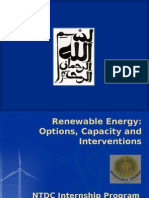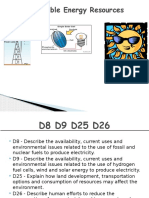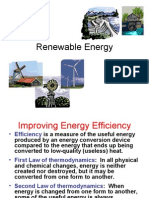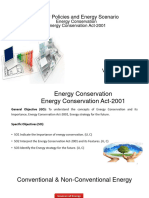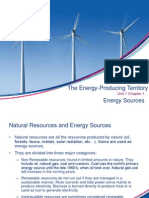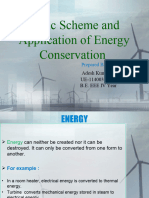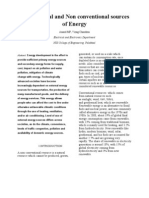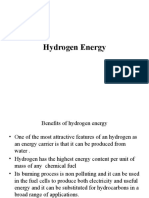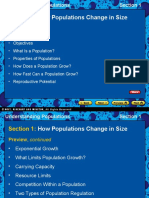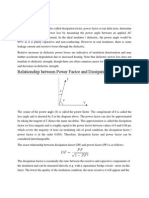Alternative Energy and Conservation: Section 2
Alternative Energy and Conservation: Section 2
Uploaded by
api-272720493Copyright:
Available Formats
Alternative Energy and Conservation: Section 2
Alternative Energy and Conservation: Section 2
Uploaded by
api-272720493Original Title
Copyright
Available Formats
Share this document
Did you find this document useful?
Is this content inappropriate?
Copyright:
Available Formats
Alternative Energy and Conservation: Section 2
Alternative Energy and Conservation: Section 2
Uploaded by
api-272720493Copyright:
Available Formats
Renewable Energy
Section 2
Section 2: Alternative Energy and Conservation
Preview
Bellringer
Objectives
Alternative Energy
Tidal Power
Ocean Thermal Energy Conservation
HydrogenA Future Fuel Source?
The Challenge of Hydrogen Fuel
Renewable Energy
Section 2
Section 2: Alternative Energy and Conservation
Preview, continued
Fuel Cells
Energy Efficiency
Efficient Transportation
Hybrid Cars
Cogeneration
Energy Conservation
Renewable Energy
Section 2
Section 2: Alternative Energy and Conservation
Preview, continued
Cities and Towns Saving Energy
Conservation Around the Home
Conservation in Daily Life
Renewable Energy
Bellringer
Section 2
Renewable Energy
Section 2
Objectives
Describe three alternative energy technologies.
Identify two ways that hydrogen could be used a fuel
source in the future.
Explain the difference between energy efficiency and
energy conservation.
Describe two forms of energy-efficient transportation.
Identify three ways that you can conserve energy
in your daily life.
Renewable Energy
Section 2
Alternative Energy
To achieve a future where energy use is sustainable, we
must make the most of the energy sources we already
have and develop new sources of energy.
Alternative energy describes energy that does not
come from fossil fuels and that is still in development.
Renewable Energy
Section 2
Alternative Energy
For an alternative energy source to become a viable
option for the future, the source must be proven to be
cost effective.
Also, the environmental effects of using the energy
source must be acceptable.
Renewable Energy
Section 2
Tidal Power
A tidal power plant works much like a hydroelectric dam.
As the tide rises, water enters a bay behind a dam. The
gate then closes at high tide.
At low tide, the gate opens and the water in the bay
rushes through, spinning a turbine that generates
electricity.
Renewable Energy
Tidal Power
Section 2
Renewable Energy
Section 2
Tidal Power
Although tidal energy is renewable and nonpolluting, it
will not become a major energy source in the future.
The cost of building and maintaining tidal power plants is
high, and there are few suitable locations.
Renewable Energy
Section 2
Ocean Thermal Energy Conservation
In the tropics, the temperature difference between the
surface of the ocean and the deep ocean waters can be
as much as 24C (43F).
Ocean thermal energy conservation (OTEC) is the use
of temperature differences in ocean water to produce
electricity.
Renewable Energy
Section 2
Ocean Thermal Energy Conservation
An OTEC plant produces energy using the following
steps
Warm surface water is boiled in a vacuum chamber.
This produces a steam that drives a turbine to
generate electricity.
Cold deep-ocean water will condense the steam.
The steam turns into water that can be used again.
Renewable Energy
Ocean Thermal Energy Conservation
Section 2
Renewable Energy
Section 2
Ocean Thermal Energy Conservation
The United States and Japan have experimented with
OTEC power, but so far, no project has been able to
generate cost effective electricity.
OTEC plants are inefficient because about one-third of
the electricity the plant produces is used to pump cold
water up from the deep ocean.
The environmental effects of pumping large amounts of
cold water to the surface are also unknown.
Renewable Energy
Section 2
Hydrogen-A Future Fuel Source?
Hydrogen, the most abundant element in the universe,
can be burned as a fuel.
Hydrogen does not contain carbon, so it does not
release pollutants associated with burning fossil fuels
and biomass.
When hydrogen is burned in the atmosphere, it
combines with oxygen to produce water vapor, a
harmless byproduct, and small amounts of nitrogen
oxides.
Renewable Energy
Section 2
Hydrogen-A Future Fuel Source?
Hydrogen gas (H2) can be produced by using electricity
to split molecules of water (H2O).
Hydrogen fuel can be made from any material that
contains a lot of hydrogen.
In the future, we may also be able to grow plants to
produce hydrogen cost effectively.
Renewable Energy
Section 2
The Challenge of Hydrogen Fuel
One difficulty of using hydrogen as a fuel today is that
hydrogen takes a lot of energy to produce.
If this energy came from burning fossil fuels, generating
hydrogen would be expensive and polluting.
Renewable Energy
Section 2
The Challenge of Hydrogen Fuel
One alternative is to use electricity from solar cells or
wind power to split water molecules to produce
hydrogen.
Hydrogen could then be stored in pressurized tanks and
transported in gas pipelines.
Or hydrogen might not be stored at all-it might be used
as it is produced, in fuel cells.
Renewable Energy
Section 2
Fuel Cells
A fuel cell is a device that produces electricity
chemically by combining hydrogen fuel with oxygen from
the air.
When hydrogen and oxygen are combined, electrical
energy is produced and water is the only byproduct.
Fuel cells can be fueled by anything that contains plenty
of hydrogen, including natural gas, alcohol, or even
gasoline.
Renewable Energy
Fuel Cells
Section 2
Renewable Energy
Section 2
Energy Efficiency
There are two main ways to reduce energy use:
lifestyle changes
increases in energy efficiency
Energy efficiency is the percentage of energy put into a
system that does useful work.
Energy efficiency can be determined by this equation:
energy efficiency (in %) = energy out/energy in 100
Renewable Energy
Energy Efficiency
Most of our devices are fairly
inefficient. More than 40
percent of all commercial
energy used in the United
States is wasted.
Increasing efficiency may
involve sacrifices or
investments in new
technology.
Section 2
Renewable Energy
Section 2
Efficient Transportation
Developing efficient engines to power vehicles and
increasing the use of public transportation systems
would help increase energy efficiency of American life.
The internal combustion engines that power most
vehicles do so inefficiently and produce air pollution.
In the next 50 years, the design of these engines may
change radically to meet the need for more efficient
transportation.
Renewable Energy
Section 2
Hybrid Cars
Hybrid cars are examples of energy-efficient vehicles.
Hybrid cars use small, efficient gasoline engines most of
the time, but they also use electric motors when extra
power is needed, such as while accelerating.
Hybrid cars do not cost much more than conventional
vehicles, they cost less to refuel, and they produce less
harmful emissions.
Renewable Energy
Hybrid Cars
Section 2
Renewable Energy
Section 2
Hybrid Cars
Hybrid cars feature many efficient technologies.
They convert some energy of braking into electricity
and store this energy in the battery.
The gasoline engine is sometimes shut off to save
fuel, such as when the car is stopped at a red light.
They are aerodynamic in design and need
less energy to accelerate.
Renewable Energy
Section 2
Cogeneration
Cogeneration is the production of two useful forms of
energy from the same fuel source.
For example, the waste heat from an industrial furnace
can power a steam turbine that produces electricity.
Small cogeneration systems have been used for years to
supply heat and electricity to multiple buildings at
specific sites.
Renewable Energy
Section 2
Energy Conservation
Energy conservation is the process of saving energy by
reducing energy use and waste.
This can occur in many ways, including using energyefficient devices and wasting less energy.
Between 1975 and 1985, conservation made more
energy available in the United States than all alternative
energy sources combined did.
Renewable Energy
Section 2
Cities and Towns Saving Energy
The town of Osage, Iowa, numbers 3,600 people.
This town saved more than $1 million each year in
energy because they found ways to conserve energy.
In addition to saving energy, the town has greatly
improved its economy through energy conservation.
Businesses have relocated to the area to take advantage
of low energy costs. Unemployment rates have also
declined.
Renewable Energy
Section 2
Conservation Around the Home
The average household in the U.S. spends more than
$1,200 on energy bills each year.
Unfortunately, much of the energy from homes is lost
through poorly insulated windows, doors, walls, and the
roof.
There are dozens of ways to reduce energy use around
the home.
Renewable Energy
Section 2
Conservation in Daily Life
There are many simple lifestyle changes that can help
save energy.
Using less of any resource usually translates into
saving energy.
Renewable Energy
Conservation Around the Home
Section 2
Renewable Energy
Quick LAB
Section 2
Renewable Energy
Graphic Organizer
Section 2
Renewable Energy
Math Practice
Section 2
You might also like
- Columns DesignDocument29 pagesColumns Designهيمة عليNo ratings yet
- WELDING QualityPlanSampleDocument20 pagesWELDING QualityPlanSamplemullanji100% (3)
- G. Tyler Miller's Living in The Environment 14 EditionDocument92 pagesG. Tyler Miller's Living in The Environment 14 EditionjyotiangelNo ratings yet
- Renewable Source of EnergyDocument23 pagesRenewable Source of Energysakthidst2003No ratings yet
- Energy ResourcesDocument69 pagesEnergy Resourcesluisa bautistaNo ratings yet
- Seminar On Power Systems: BY: Sarmishtha Satpathy REGD NO: 0701209432 Applied Electronics & Instrumentation EnggDocument18 pagesSeminar On Power Systems: BY: Sarmishtha Satpathy REGD NO: 0701209432 Applied Electronics & Instrumentation EnggSachin SrivastavNo ratings yet
- Energy Emerging Trends & StorageDocument95 pagesEnergy Emerging Trends & StorageyohapriyavenkatesanNo ratings yet
- Energy Resources: Ellaine Claire C. Pahunang Lyriel Mae A - Desoyo Grade 11-GammaDocument33 pagesEnergy Resources: Ellaine Claire C. Pahunang Lyriel Mae A - Desoyo Grade 11-GammaLyriel DesoyoNo ratings yet
- Renewable Sources of Energy1Document18 pagesRenewable Sources of Energy1Arpit KapoorNo ratings yet
- Lec1 2Document55 pagesLec1 2FarwaNo ratings yet
- Aee Slides1Document46 pagesAee Slides1kannanNo ratings yet
- Lecture 1a. Choice of energy source. RenewablesDocument47 pagesLecture 1a. Choice of energy source. RenewablesIgombe IsaacNo ratings yet
- Week 3rd 1st Quarter Renewable Energy Curriculum For GO3 ProjDocument40 pagesWeek 3rd 1st Quarter Renewable Energy Curriculum For GO3 ProjRhea Ann CaparasNo ratings yet
- Renewable Energy: Options, Capacity and InterventionsDocument50 pagesRenewable Energy: Options, Capacity and InterventionsMuhammad Salman ArshidNo ratings yet
- APES 2e TRM CH 13 PPT Presentation 13Document41 pagesAPES 2e TRM CH 13 PPT Presentation 13itsknkmshrNo ratings yet
- Energy ResourcesDocument36 pagesEnergy ResourcesHarjot KaurNo ratings yet
- ch18 Sec1Document36 pagesch18 Sec1api-272720493100% (1)
- Renewable Energy ResourcesDocument27 pagesRenewable Energy ResourcesEng Bile LastroNo ratings yet
- BSC Environmental Management Semester Ii, Spring Semester 2021Document22 pagesBSC Environmental Management Semester Ii, Spring Semester 2021Temphel LhendupNo ratings yet
- modeling and analysis of renewable energy systems المعدل pptxDocument37 pagesmodeling and analysis of renewable energy systems المعدل pptxanwar.23enp30No ratings yet
- EVS Chapter 3Document48 pagesEVS Chapter 3see19rsNo ratings yet
- Renewable EnergyDocument53 pagesRenewable Energymido17619487No ratings yet
- Alternative Energies: MVZ Carinthia ZapataDocument19 pagesAlternative Energies: MVZ Carinthia ZapataFer ArauzoNo ratings yet
- EE1451 RES 2 Mark Q & ADocument34 pagesEE1451 RES 2 Mark Q & AKrishnaram Kaliaperumal91% (33)
- Home Fuel Cell: Presented By-Sampurnanand MishraDocument26 pagesHome Fuel Cell: Presented By-Sampurnanand Mishrasampurnanand mishraNo ratings yet
- Vinesh SirDocument26 pagesVinesh SirshankergodwalNo ratings yet
- EVS - UNIT III - Renewable Sources of EnergyDocument53 pagesEVS - UNIT III - Renewable Sources of Energyromanreigns19393No ratings yet
- 21ee035u1 LM4Document41 pages21ee035u1 LM4dhanush.ee21No ratings yet
- ENV1 Chapter 18 Renewable Energy ResourcesDocument63 pagesENV1 Chapter 18 Renewable Energy ResourcesAnita FuloNo ratings yet
- Unit 1 The Energy Producing SourcesDocument45 pagesUnit 1 The Energy Producing Sourcesapi-241427002No ratings yet
- 07 08 2009 PMEL Energy Source Enviroment GHG 5Document28 pages07 08 2009 PMEL Energy Source Enviroment GHG 5bangkit1110No ratings yet
- IntroductionDocument29 pagesIntroductionAaqibRNo ratings yet
- Non Renewable SourcesDocument95 pagesNon Renewable SourcesS.m. FerdousNo ratings yet
- Solar Energy Vs Alternative Sources of Energy: Visvesvaraya Technological University Jnana Sangama, Belagavi-590018Document12 pagesSolar Energy Vs Alternative Sources of Energy: Visvesvaraya Technological University Jnana Sangama, Belagavi-590018m s supritaNo ratings yet
- Unit 2_Session 2_Save EnergyDocument35 pagesUnit 2_Session 2_Save Energysaisiddhartha606No ratings yet
- Marine Propulsion Engines and Renewable Energies: NME 463 By: Dr. Waleed YehiaDocument33 pagesMarine Propulsion Engines and Renewable Energies: NME 463 By: Dr. Waleed YehiawaleedyehiaNo ratings yet
- Unit IiiDocument48 pagesUnit IiiVD King BrothersNo ratings yet
- 2365 - 02 - l2 - 203 - Presentation - 27 ModDocument23 pages2365 - 02 - l2 - 203 - Presentation - 27 Modshahin.noktehdan4102No ratings yet
- Renewable Energy NotesDocument9 pagesRenewable Energy NotesGokul LukogNo ratings yet
- Energy Conversion Technologies & HydrogenDocument18 pagesEnergy Conversion Technologies & Hydrogenanon-530265100% (2)
- Ch 9 part 2 Sustainable energyDocument60 pagesCh 9 part 2 Sustainable energysabymohx97No ratings yet
- EnergyDocument24 pagesEnergyravatankit972No ratings yet
- Chapter 17 Energy Some BasicsDocument46 pagesChapter 17 Energy Some BasicsCarmen LawsonNo ratings yet
- Alternative Sources of Energy in DetailDocument22 pagesAlternative Sources of Energy in DetailPRIYA MISHRANo ratings yet
- Energy Management SystemDocument92 pagesEnergy Management SystemEijay ReyesNo ratings yet
- CapstoneDocument9 pagesCapstoneavanthikaasri mNo ratings yet
- ElecDocument34 pagesElecWaleedNo ratings yet
- EnergyDocument52 pagesEnergyJincheng CaiNo ratings yet
- Conventional and Non Conventional Sources of EnergyDocument14 pagesConventional and Non Conventional Sources of EnergyVizag ChandranNo ratings yet
- Chapter 1 - Lec 2Document26 pagesChapter 1 - Lec 2Vinay PrakashNo ratings yet
- Renewable Energy in Global PerspectiveDocument43 pagesRenewable Energy in Global PerspectiveKhalil RazaNo ratings yet
- Unit 1Document9 pagesUnit 1Angoth kishanNo ratings yet
- HEV Unit 2Document147 pagesHEV Unit 2notes660853No ratings yet
- On Renewable EnergyDocument6 pagesOn Renewable Energymishra.bibha119No ratings yet
- Hydrogen VehiclesDocument2 pagesHydrogen VehiclesHari KrishnaNo ratings yet
- Energy Management - Ivin & TeamDocument27 pagesEnergy Management - Ivin & TeamIvin MichaelNo ratings yet
- PhysicsDocument22 pagesPhysicsagrawalronak432No ratings yet
- OCH353 - Unit 1Document63 pagesOCH353 - Unit 1ramanathan1961No ratings yet
- Module 3Document31 pagesModule 3thripthi shettyNo ratings yet
- Lec 7 - Methods of Energy Conservation and Improving EfficiencyDocument20 pagesLec 7 - Methods of Energy Conservation and Improving EfficiencyJavonie ScottNo ratings yet
- The Future of Energy: Innovations in Renewable Resources and ConservationFrom EverandThe Future of Energy: Innovations in Renewable Resources and ConservationNo ratings yet
- Park DBQ: InstructionsDocument1 pagePark DBQ: Instructionsapi-272720493No ratings yet
- America Aljazeera Com-Worlds Largest Tax-Funded Site of Mass Graves Might Be Turned Into A ParkDocument2 pagesAmerica Aljazeera Com-Worlds Largest Tax-Funded Site of Mass Graves Might Be Turned Into A Parkapi-272720493No ratings yet
- Env Stream LabDocument3 pagesEnv Stream Labapi-272720493No ratings yet
- Chemistry of Life FoldableDocument2 pagesChemistry of Life Foldableapi-272720493No ratings yet
- ch08 Sec1Document26 pagesch08 Sec1api-272720493No ratings yet
- Travel Brochure of A CellDocument1 pageTravel Brochure of A Cellapi-272720493No ratings yet
- Invite EsDocument1 pageInvite Esapi-272720493No ratings yet
- Invite PsDocument1 pageInvite Psapi-272720493No ratings yet
- InviteDocument1 pageInviteapi-272720493No ratings yet
- EcologyDocument92 pagesEcologyapi-272720493No ratings yet
- Kingdom Taxonomy Project 15Document5 pagesKingdom Taxonomy Project 15api-272720493No ratings yet
- Agriculture Fact Sheet Jackson 2009Document4 pagesAgriculture Fact Sheet Jackson 2009api-272720493No ratings yet
- ESD5100 Series Speed Control UnitDocument2 pagesESD5100 Series Speed Control Unitajcapetillog100% (2)
- SPR York 4 14 Line Boring Spec SheetDocument2 pagesSPR York 4 14 Line Boring Spec SheetАлмаз КенжетаевNo ratings yet
- Physics 02-03 FrictionDocument2 pagesPhysics 02-03 FrictiontonisupriadiNo ratings yet
- Stavely Python Ebook PDFDocument260 pagesStavely Python Ebook PDFArie Wila KautsarNo ratings yet
- 450w Era Solar BifacialDocument1 page450w Era Solar BifacialGrupo LedNo ratings yet
- Is 9434 1992Document26 pagesIs 9434 1992Reza RhiNo ratings yet
- Fluidbed ReferenceDocument37 pagesFluidbed ReferenceAzharuddin_kfupmNo ratings yet
- How To Download Scribd Documents For Free: Mac Windows Iphone Android Web Apps Security Gaming Gadgets Social MediaDocument14 pagesHow To Download Scribd Documents For Free: Mac Windows Iphone Android Web Apps Security Gaming Gadgets Social MediasskumasNo ratings yet
- DLA Testing: Relationship Between Power Factor and Dissipation FactorDocument3 pagesDLA Testing: Relationship Between Power Factor and Dissipation FactormshahidshaukatNo ratings yet
- ME324 Jeopardy2Document22 pagesME324 Jeopardy2Catherine AndersonNo ratings yet
- Building Technology 4: Specification Writing and EstimatingDocument26 pagesBuilding Technology 4: Specification Writing and EstimatingKhiara May FabulaNo ratings yet
- Glass Containers Food Glass Jar Quality StandardDocument7 pagesGlass Containers Food Glass Jar Quality StandardKandaswamy VajjiraveluNo ratings yet
- "Uaht" Brake CylindersDocument8 pages"Uaht" Brake CylindersArmando RodriguezNo ratings yet
- Defect & Outstanding ListDocument38 pagesDefect & Outstanding ListMohd AzwanNo ratings yet
- Drilled Shaft & CofferdamDocument48 pagesDrilled Shaft & Cofferdamsmugler 123No ratings yet
- Visco-Elastic CoatingsDocument7 pagesVisco-Elastic CoatingsXiaohua ChenNo ratings yet
- GemsDocument68 pagesGemssaopauloNo ratings yet
- Measurement 0625 - s12 - QP - 31Document1 pageMeasurement 0625 - s12 - QP - 31Nicole NicoleNo ratings yet
- Irvin Langmuir 1918, Adsorption IsothermDocument43 pagesIrvin Langmuir 1918, Adsorption IsothermJayvir100% (3)
- All India Cfo Cio Ceo Data SampleDocument5 pagesAll India Cfo Cio Ceo Data SampleMuralidhara PrasadNo ratings yet
- Mining and Earthmoving: Estimating Production Off-the-Job Example Problem (English) Example Problem (Metric)Document4 pagesMining and Earthmoving: Estimating Production Off-the-Job Example Problem (English) Example Problem (Metric)ali alilouNo ratings yet
- Polypropylene PipesDocument2 pagesPolypropylene PipesMOHAMMAD ASIFNo ratings yet
- M215 Va11Document3 pagesM215 Va11Péter SpiegelbergerNo ratings yet
- Steve Pomeroy's ResumeDocument2 pagesSteve Pomeroy's ResumexxvelcrarNo ratings yet
- List-2 LakhsDocument28 pagesList-2 LakhsMuthumariGanesanNo ratings yet
- Design of FPGA-based Traffic Light Controller System: June 2011Document6 pagesDesign of FPGA-based Traffic Light Controller System: June 2011korsairNo ratings yet
- Urbi SDKDocument636 pagesUrbi SDKSereen MaaNo ratings yet













